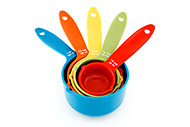
Fitness goals can be too specific. When you select an exact goal weight or a specific time for completing a race, you are emphasizing perfection. If you slightly miss your goal weight or if you don’t meet your target race time, you feel like a failure. This way of viewing fitness undervalues the progress you have made because you are striving for what you picture as an ideal result.
Choose ranges
Take your focus off of a golden number. If your goal is to lose 20 pounds in 6 months and you lose 19, you have accomplished a lot. But you may be so focused on not reaching 20 that you fail to see your progress. Use ranges for all of your goals. Lose 18 to 20 pounds, or reach a goal weight of 145 to 150 pounds. Eat 3 to 5 servings of vegetables, or finish the 5K in 30 to 33 minutes. Goals that include a range are specific enough to motivate you, but they put less pressure on perfection, allowing you to celebrate your progress.
Select supporting goals
While your primary goal may be weight loss, other health indicators may help you stay motivated, too. By tracking your blood pressure, heart rate and body fat, the positive changes in these areas can serve as motivation when you hit a plateau on the scale. Exercise goals work similarly. Maybe you can’t run 6 miles yet without walking, but your upper body strength or lower body flexibility may have increased beyond your expectations.
Measure often
Set up a schedule to measure your progress regularly. Weigh yourself weekly, measure your blood pressure monthly, or assess your body fat every three months. This allows you to adjust your program if you aren’t seeing the changes you want while allowing enough time for your new habits to have a positive impact on your health.



 8 Ways to Overcome a Lack of Support for Weight Loss
8 Ways to Overcome a Lack of Support for Weight Loss
 6 Tips for Controlling Portions
6 Tips for Controlling Portions
 Some People Dream of Success
Some People Dream of Success
 5 Breakfasts Under 300 Calories
5 Breakfasts Under 300 Calories
 4 Things to Know About Negative Calorie Diets
4 Things to Know About Negative Calorie Diets
 Healthy Ways to Motivate Your Friends
Healthy Ways to Motivate Your Friends
 15 Bites and Nibbles That Keep You From Losing Weight
15 Bites and Nibbles That Keep You From Losing Weight
 Recover from Weight Loss Setbacks
Recover from Weight Loss Setbacks

 Pinterest
Pinterest RSS Feed
RSS Feed